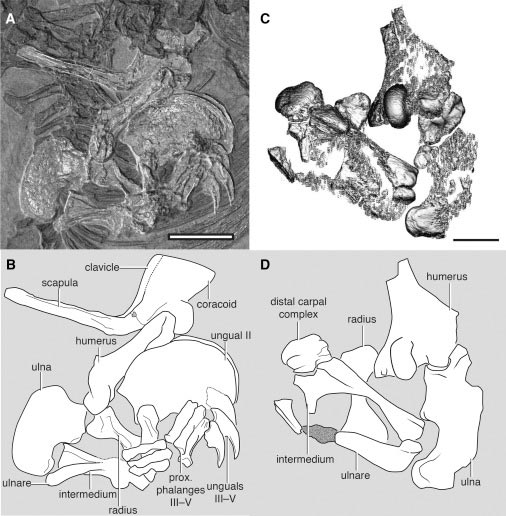You Have Just Got to Hand it to Drepanosaurus unguicaudatus
A team of international scientists including researchers from a number of eminent American scientific institutions (Stony Brook University, The Dinosaur Institute at the Los Angeles County Natural History Museum and the Natural History Museum of Utah, have published a remarkable description of a Late Triassic, diapsid reptile that overturns the rule book when it comes to tetrapod limbs.
Writing in the journal ” Current Biology”, the small-bodied, possible arboreal, reptile called Drepanosaurus unguicaudatus had the most astonishing forelimbs, the configuration of the bones that make up the forelimb are quite unlike anything previously seen.
Forelimb Specimens of Drepanosaurus unguicaudatus from the Chinle Formation (New Mexico)
Picture credit: Current Biology
Upsetting the Tetrapod Blueprint
Tetrapods, in essence all four-limbed vertebrates and that includes us, have shown remarkable consistency in the structure and anatomy of their limbs over the 375 million years or so since the very first tetrapods evolved (Late Devonian). Tetrapod limbs may have become adapted for all sorts of functions, such as locomotion, climbing, swimming, digging or even manipulation of small objects via being able to pronate the limbs (something that we humans can do very well), but despite this enormous array or functions, the bones of the forelimb have remained largely unchanged.
Most tetrapods have parallel shafts of bone (the radius and ulna), in the forelimb. The ulna is the medial bone, the radius is the bone furthest away from the centre of the body. The forelimb bones of D. unguicaudatus are very different.
For replicas and models of prehistoric animals, take a look at the remarkable Rebor range: Rebor Prehistoric Animal Models.
Drepanosaurus unguicaudatus
Examination of a number of specimens excavated from a quarry that forms part of the Petrified Forest Member of the Chinle Formation of northern New Mexico, revealed that this Late Triassic reptile had a flattened, crescent-shaped ulna and shaft-like carpal bones. The second digit (the index finger if you like), supported an enormous and strongly curved claw somewhat reminiscent of the claw on a Silky Anteater (Cyclopes didactylus). It has been proposed that the bizarre Drepanosaurus lived in trees and used its long claw and strong arms to rake the bark and to prise insects out of cracks and crevices.
The scientists conclude that the forelimbs of this small reptile (it grew to about sixty centimetres in length, possibly a little more), were adapted to a “hook and pull” niche seen in extant arboreal animals such as the Silky Anteater. This huge claw gave Drepanosaurus its genus name “sickle lizard”, the claw on the second digit was bigger than the whole of the rest of the hand.
One Very Bizarre Reptile
Named and described in 1979 from a single, badly crushed specimen found in Italy, Drepanosaurus may represent an “experiment” in tetrapod evolution, with this animal adapting to a very specific niche. How specialised Drepanosaurus was has only been revealed following extensive CT scans of more fossils, this time excavated from a site known as Hayden Quarry from northern New Mexico.
An Illustration of Drepanosaurus unguicaudatus
Picture credit: Victor Leshyk
Drepanosaurus has been described as having a bird-like head, on the body of a chameleon with a humped back (possibly to anchor strong back muscles), disproportionately oversized forelimbs and a long tail with a claw on the end (presumably to help the animal gain a grip on a tree branch). We like to think of Drepanosaurus as a reptilian equivalent of Popeye!
What Would Darwin Think?
Charles Darwin used the similar anatomies found in tetrapod forelimbs to support his idea that all these animals shared a common ancestor. This biological principle of common, shared traits is called homology. Charles Darwin argued that the consistencies found in the bones and their configuration in four-limbed creatures supported the idea of evolution. We wonder what the great man would have made of Drepanosaurus?
Visit Everything Dinosaur’s award-winning website: Everything Dinosaur.








Leave A Comment